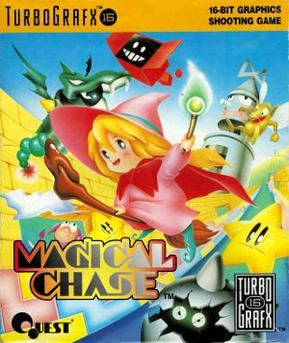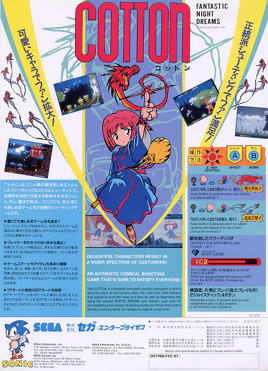
The PC-FX is a 32-bit home video game console developed by NEC and Hudson Soft. It was released in 1994 and discontinued in February 1998, as NEC's final home video game console. Based on the NEC V810 CPU and CD-ROM, it was intended as the successor to the PC Engine. Unlike its predecessor, the PC-FX was only released in Japan.

The TurboGrafx-16, known as the PC Engine outside North America, is a home video game console designed by Hudson Soft and sold by NEC Home Electronics. It was the first console marketed in the fourth generation, commonly known as the 16-bit era, though the console has an 8-bit central processing unit (CPU) coupled with a 16-bit graphics processor. It was released in Japan in 1987 and in North America in 1989. In Europe, the console is known as the PC Engine, after the Japanese model was imported and distributed in the United Kingdom and France from 1988. In Japan, the system was launched as a competitor to the Famicom, but the delayed United States release meant that it ended up competing with the Sega Genesis and later the Super NES.

Hudson Soft Co., Ltd. was a Japanese video game company that released numerous games for video game consoles, home computers and mobile phones, mainly from the 1980s to the 2000s. It was headquartered in the Midtown Tower in Tokyo, with an additional office in the Hudson Building in Sapporo.
In the history of video games, the fourth generation of video game consoles, more commonly referred to as the 16-bit era, began on October 30, 1987, with the Japanese release of NEC Home Electronics' PC Engine. Though NEC released the first console of this era, sales were mostly dominated by the rivalry between Sega and Nintendo across most markets: the Sega Mega Drive and the Super Nintendo Entertainment System. Cartridge-based handheld consoles became prominent during this time, such as the Nintendo Game Boy (1989), Atari Lynx (1989), Sega Game Gear (1990) and TurboExpress (1990).

Raiden is a 1990 vertically scrolling shooter arcade video game developed by Seibu Kaihatsu and published by Tecmo in Japan. The game's story takes place in the year 2090, when an alien species known as the Crystals invaded Earth. Players assume the roles of the Vanquish Crystal Defense pilot duo, taking control of two state of the art Fighting Thunders aircraft to defeat the Crystals and save the Earth.

The PC Engine SuperGrafx, also known as simply the SuperGrafx, is a fourth-generation home video game console manufactured by NEC Home Electronics and released in Japan in 1989. It is the successor system to the PC Engine, released two years prior. Originally known as the PC Engine 2 during production stages, it was purported as a true 16-bit home console, featuring improved graphics and audio capabilities over its predecessor.
Bonk, known as PC-Genjin in Japan and as PC Kid or BC Kid in PAL territories, is a video game character and former mascot for NEC's PC Engine/TurboGrafx-16 video game console. Three platform games featuring the character appeared on the PC Engine/TurboGrafx-16, as well as two spin-offs featuring Air Zonk. The protagonist is a bald caveman named Bonk who attacks using his comically large head.

The TurboDuo is a fourth-generation video game console developed by NEC Home Electronics and Hudson Soft for the North American market. The TurboDuo was test-marketed in Los Angeles in October 1992, before a nationwide rollout in May 1993. It is the North American version of the Japanese PC Engine Duo game console which was released in September 1991.

Military Madness is a 1989 turn-based strategy video game originally developed and published by Hudson Soft in Japan and NEC in North America for the TurboGrafx-16. It is the first entry in the Nectaris series. Set in the year 2089, players take command of the Allied-Union forces in a desperate offense against the Axis-Xenon Empire army on the Moon before they launch the S.A.M. weapon to obliterate Earth. Its gameplay consists of moving units into positions to confront enemies in turn-based encounters determined by multiple factors, capturing factories to produce resources and repair units in order to occupy the enemy prison camp or destroy all enemy forces.

The HuCard is a ROM cartridge in the form of a card, designed by Hudson Soft for NEC's PC Engine and PC Engine SuperGrafx video game consoles, which were originally released in 1987 and 1989, respectively. In the United States, where the PC Engine was marketed as the TurboGrafx-16, the HuCard is alternately called the TurboChip.

Magical Chase is a 1991 horizontally scrolling shooter video game developed by Quest and published by Palsoft and Turbo Technologies Inc. for the TurboGrafx-16. The game stars a young witch apprentice named Ripple, who broke a promise to her teacher by accidentally releasing six demons from a forbidden book, joined by her star companions Topsy and Turvy on a quest to catch and seal the demons back into the book.

Bonk's Adventure, known as PC Genjin in Japan and PC Kid in Europe, is a scrolling platform game developed by Red Company and Atlus and released in 1989 in Japan and 1990 in North America for the PC Engine/TurboGrafx-16. The Japanese title PC Genjin is a play on the system's original name, PC Engine, with the European title PC Kid similarly referencing the system's name. The first game in the Bonk series, it was followed by two more games for the TurboGrafx-16 before branching out to other platforms.

Neutopia II is a 1991 action-adventure/action role-playing video game developed and published in Japan by Hudson Soft and in North America by Turbo Technologies for the TurboGrafx-16. It is the sequel to Neutopia, which was released earlier in 1989. In the game, the player takes control of Jazeta's son, who embarks on a quest to both save his father and defeat the returning evil demon Dirth.

Gunhed, known as Blazing Lazers in North America, is a vertically scrolling shooter game by Hudson Soft and Compile, based on the Japanese film Gunhed. The title was released in 1989, for the PC Engine in Japan and re-skinned for the TurboGrafx-16 in North America, with Gunhed unofficially imported for the PC Engine in Europe. In the game, a fictional galaxy is under attack by an enemy space armada called the Dark Squadron, and this galaxy's only chance for survival is the Gunhed Advanced Star Fighter, who must destroy the Dark Squadron and its Super Weapons. The gameplay features fast vertical scrolling and a wide array of weapons for the player to use.

Super Star Soldier is a scrolling shooter video game developed by Kaneko and originally published by Hudson Soft in 1990 for the Japanese PC Engine and in 1991 for the North American TurboGrafx-16. It is the sequel to Star Soldier, and part of a vertical-scrolling shooter series by Hudson Soft. According to the company, many people believed Super Star Soldier's graphics were the best of any HuCard game. Although the game was popular in Japan, it received less attention from the rest of the world.

Gate of Thunder is a 1992 scrolling shooter video game developed by Red Company and published by Hudson Soft for the TurboGrafx-CD. It was the first game released in North America to support the Super CD-ROM² format and served as one of the pack-in games for the TurboDuo, a two-in-one system which runs both TurboGrafx-CD and TurboGrafx-16 titles, where it was bundled with Bonk's Adventure, Bonk's Revenge and Bomberman on the same disc. In the game, the player controls the Hunting Dog space fighter craft, piloted by space cop Hawk. Alongside his ally Esty, piloting the Wild Cat support ship, Hawk must stop General Don Jingi and his Obellon armada from obtaining the powerful "Starlight" energy source from planet Aries.

Star Parodier is a vertical-scrolling shoot 'em up video game developed by Kaneko and published by Hudson Soft for the PC Engine CD-ROM² in 1992. It is a spin-off of the Star Soldier series and was localized for North America as Fantasy Star Soldier, but this version was never released. The game was released for the Wii Virtual Console on March 7, 2008 in Japan, March 16 in Europe and later in North America on August 11. The title is also playable on the Turbografx-16/PC Engine Mini Console.

Cotton: Fantastic Night Dreams is a scrolling shooter video game developed by Success and originally released in Japanese arcades in 1991. The first installment in the Cotton series, players assume the role of the young witch Cotton who, alongside her fairy companion Silk, sets out on her broomstick on a quest to defeat several monsters and get her Willow candy. Its gameplay mainly consists of shooting mixed with role-playing game elements using a main two-button configuration. It ran on the Sega System 16 hardware.
The TurboGrafx-16 Mini, also known as the PC Engine Mini in Japan and PC Engine CoreGrafx Mini in Europe, is a dedicated home video game console by Konami modeled on NEC's TurboGrafx-16, which was designed by Hudson Soft, a video game developer which Konami acquired in 2012. The Mini emulates the original console's 8-bit hardware. The Japanese model contains 58 games in total while the international models contain 57. The Mini was originally set to be released worldwide on March 19, 2020, exclusively through Amazon, but was delayed everywhere except for Japan because of the COVID-19 pandemic. It was shipped in North America on May 22, 2020, and in Europe on June 5, 2020.
















